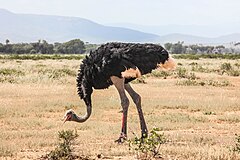Struthio
Struthio – rodzaj dużych ptaków z rodziny strusiów (Struthionidae).
| Struthio[1] | |||
| Linnaeus, 1758[2] | |||
 Przedstawiciel rodzaju – struś szaroskóry (S. molybdophanes) | |||
| Systematyka | |||
| Domena | |||
|---|---|---|---|
| Królestwo | |||
| Typ | |||
| Podtyp | |||
| Gromada | |||
| Podgromada | |||
| Infragromada | |||
| Rząd | |||
| Rodzina | |||
| Rodzaj |
Struthio | ||
| Typ nomenklatoryczny | |||
|
Struthio camelus Linnaeus, 1758 | |||
| Synonimy | |||
|
| |||
| Gatunki | |||
| |||
Zasięg występowania edytuj
Morfologia edytuj
Długość ciała samic 175–190 cm, samców 210–275 cm; masa ciała samic 90–110 kg, samców 100–156 kg[6].
Systematyka edytuj
Etymologia edytuj
- Struthio: łac. struthiocamelus „struś”, od gr. στρουθοκαμηλος strouthokamēlos lub στρουθος strouthos „struś” (te ostatnie zwykle stosowane do małych, wróblopodobnych ptaków, ale tu użyte w sensie „(wielki) ptak”)[7].
- Struthiolithus: rodzaj Struthio Linnaeus, 1758; gr. λιθος lithos „kamień”[8]. Gatunek typowy: †Struthiolithus chersonensis von Brandt, 1872.
- Megaloscelornis: gr. μεγας megas, μεγαλη megalē „wielki”; σκελος skelos „noga”; ορνις ornis, ορνιθος ornithos „ptak”[9]. Gatunek typowy: †Megaloscelornis sivalensis Lyddaker, 1879.
- Pachystruthio: gr. παχυς pakhus „gruby”; rodzaj Struthio Linnaeus, 1758. Nazwa zastępcza dla Struthiolithus Brandt, 1872, którą Kretzoi uznał za niestosowną, ponieważ została oparta na fragmentach skorupy jaja[10].
Podział systematyczny edytuj
Do rodzaju należą następujące gatunki[11]:
- Struthio camelus Linnaeus, 1758 – struś czerwonoskóry
- Struthio molybdophanes d’Orbigny, 1834 – struś szaroskóry – takson wyodrębniony ostatnio na podstawie analiz genetycznych z S. camelus[12][13]
a także gatunki wymarłe, w tym:
Przypisy edytuj
- ↑ Struthio, [w:] Integrated Taxonomic Information System (ang.).
- ↑ C. Linnaeus: Systema naturae per regna tria naturae :secundum classes, ordines, genera, species, cum characteribus, differentiis, synonymis, locis. Wyd. 10. T. 1. Holmiae: Impensis Direct. Laurentii Salvii, 1758, s. 155. (łac.).
- ↑ J.F. von Brandt. Über ein grosses fossiles Vogelei aus der Umgegend von Cherson. „Bulletin de l’Académie impériale des sciences de St.-Pétersbourg”. 18 (2), s. 161, 1872. (niem.).
- ↑ R. Lydekker. Notes on some Siwalik Birds. „Records of the Geological Survey of India”. 12, s. 56, 1879. (ang.).
- ↑ M. Kretzoi. Strucc-maradványok a fejēr megyei Kislángról. „Aquila”. 59–62, s. 365, 1952–1955. (węg.).
- ↑ a b D.W. Winkler, S.M. Billerman & I.J. Lovette: Hornbills (Bucerotidae), version 1.0. W: S.M. Billerman, B.K. Keeney, P.G. Rodewald & T.S. Schulenberg (red.): Birds of the World. Ithaca, NY: Cornell Lab of Ornithology, 2020. DOI: 10.2173/bow.bucero1.01. [dostęp 2020-06-16]. (ang.).
- ↑ The Key to Scientific Names ↓, Struthio [dostęp 2022-02-02].
- ↑ The Key to Scientific Names ↓, Struthiolithus [dostęp 2022-02-02].
- ↑ The Key to Scientific Names ↓, Megaloscelornis [dostęp 2022-02-02].
- ↑ The Key to Scientific Names ↓, Pachystruthio [dostęp 2022-02-02].
- ↑ Systematyka i nazwy polskie za: P. Mielczarek & M. Kuziemko: Rodzina: Struthionidae Vigors, 1825 - strusie - Ostriches (Wersja: 2015-08-29). [w:] Kompletna lista ptaków świata [on-line]. Instytut Nauk o Środowisku Uniwersytetu Jagiellońskiego. [dostęp 2020-06-16].
- ↑ S. Freitag & T.J. Robinson. Phylogeographic Patterns in Mitochondrial DNA of the Ostrich (Strutio camelus). „The Auk”. 110 (3), s. 614–622, 1993. (ang.).
- ↑ J.M. Miller, S. Hallager, S.L. Monfort, J. Newby, K. Bishop, S.A. Tidmus, P. Black, B. Houston, C.A. Matthee & R.C. Fleischer. Phylogeographic analysis of nuclear and mtDNA supports subspecies designations in the ostrich (Struthio camelus). „Conservation Genetics”. 12 (2), s. 423–431, 2011. DOI: 10.1007/s10592-010-0149-x. (ang.).
- ↑ Cécile Mourer-Chauviré, Denis Geraads. The Struthionidae and Pelagornithidae (Aves: Struthioniformes, Odontopterygiformes) from the late Pliocene of Ahl al Oughlam, Morocco. „6`eme Symposium international de la Society for Avian Paleontology and Evolution (SAPE), 2005, Esperaza, France”, s. 169–194, 2008.
Bibliografia edytuj
- The Key to Scientific Names, J.A. Jobling (red.), [w:] Birds of the World, S.M. Billerman et al. (red.), Cornell Lab of Ornithology, Ithaca (ang.).